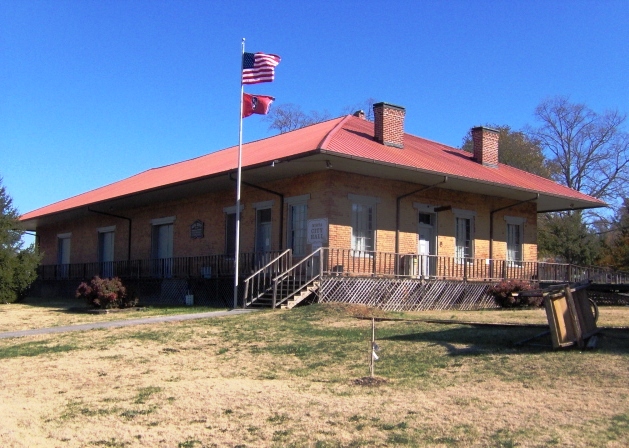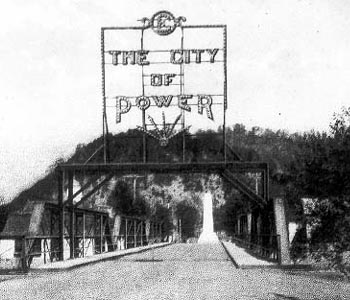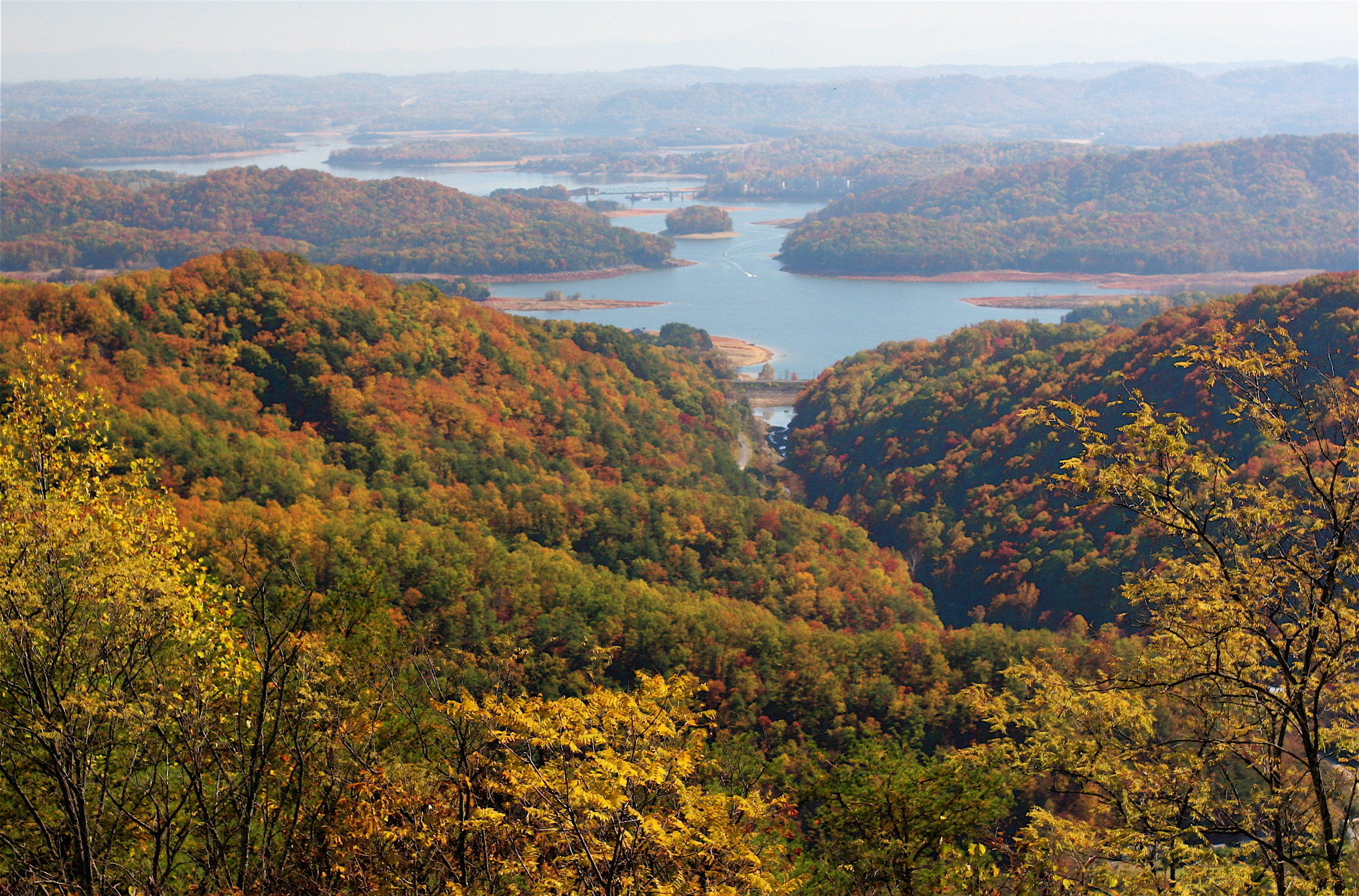|
Watauga, Tennessee
Watauga is a city in Carter and Washington counties in the U.S. state of Tennessee. The population was 403 at the 2000 census and 458 at the 2010 census. It is part of the Johnson City Metropolitan Statistical Area, which is a component of the Johnson City– Kingsport–Bristol, TN- VA Combined Statistical Area – commonly known as the " Tri-Cities" region. History Some of the earliest European pioneers in Tennessee settled in the vicinity of Watauga in the mid-18th century. William Bean, traditionally recognized as Tennessee's first white settler, built his cabin at the mouth of Boone Creek, downstream from modern Watauga, in 1769. The Watauga Association, an early frontier government, operated out of nearby Elizabethton in the 1770s. When the East Tennessee and Virginia Railroad (ET&V) was built in the 1850s, a railroad stop known as Carter's Depot, or Carter's Station, was established at what is now Watauga, where a trestle had been erected to carry the tracks ... [...More Info...] [...Related Items...] OR: [Wikipedia] [Google] [Baidu] |
City
A city is a human settlement of notable size.Goodall, B. (1987) ''The Penguin Dictionary of Human Geography''. London: Penguin.Kuper, A. and Kuper, J., eds (1996) ''The Social Science Encyclopedia''. 2nd edition. London: Routledge. It can be defined as a permanent and densely settled place with administratively defined boundaries whose members work primarily on non-agricultural tasks. Cities generally have extensive systems for housing, transportation, sanitation, utilities, land use, production of goods, and communication. Their density facilitates interaction between people, government organisations and businesses, sometimes benefiting different parties in the process, such as improving efficiency of goods and service distribution. Historically, city-dwellers have been a small proportion of humanity overall, but following two centuries of unprecedented and rapid urbanization, more than half of the world population now lives in cities, which has had profound consequences for g ... [...More Info...] [...Related Items...] OR: [Wikipedia] [Google] [Baidu] |
Kingsport, Tennessee
Kingsport is a city in Sullivan and Hawkins counties in the U.S. state of Tennessee. As of the 2020 census, its population was 55,442. Lying along the Holston River, Kingsport is commonly included in what is known as the Mountain Empire, which spans a portion of southwest Virginia and the mountainous counties in northeastern Tennessee. It is the largest city in the Kingsport–Bristol metropolitan area, which had a population of 307,614 in 2020. The metro area is a component of the larger Tri-Cities region of Tennessee and Virginia, with a population of 508,260 in 2020. The name "Kingsport" is a simplification of "King's Port", originally referring to the area on the Holston River known as King's Boat Yard, the head of navigation for the Tennessee Valley. History Kingsport was developed after the Revolutionary War, at the confluence of the North and South Forks of the Holston River. In 1787 it was known as "Salt Lick" for an ancient mineral lick. It was first settle ... [...More Info...] [...Related Items...] OR: [Wikipedia] [Google] [Baidu] |
Confederate States Army
The Confederate States Army, also called the Confederate Army or the Southern Army, was the military land force of the Confederate States of America (commonly referred to as the Confederacy) during the American Civil War (1861–1865), fighting against the United States forces to win the independence of the Southern states and uphold the institution of slavery. On February 28, 1861, the Provisional Confederate Congress established a provisional volunteer army and gave control over military operations and authority for mustering state forces and volunteers to the newly chosen Confederate president, Jefferson Davis. Davis was a graduate of the U.S. Military Academy, and colonel of a volunteer regiment during the Mexican–American War. He had also been a United States senator from Mississippi and U.S. Secretary of War under President Franklin Pierce. On March 1, 1861, on behalf of the Confederate government, Davis assumed control of the military situation at Charleston, South C ... [...More Info...] [...Related Items...] OR: [Wikipedia] [Google] [Baidu] |
American Civil War
The American Civil War (April 12, 1861 – May 26, 1865; also known by other names) was a civil war in the United States. It was fought between the Union ("the North") and the Confederacy ("the South"), the latter formed by states that had seceded. The central cause of the war was the dispute over whether slavery would be permitted to expand into the western territories, leading to more slave states, or be prevented from doing so, which was widely believed would place slavery on a course of ultimate extinction. Decades of political controversy over slavery were brought to a head by the victory in the 1860 U.S. presidential election of Abraham Lincoln, who opposed slavery's expansion into the west. An initial seven southern slave states responded to Lincoln's victory by seceding from the United States and, in 1861, forming the Confederacy. The Confederacy seized U.S. forts and other federal assets within their borders. Led by Confederate President Jefferson Davis, ... [...More Info...] [...Related Items...] OR: [Wikipedia] [Google] [Baidu] |
Watauga River
The Watauga River () is a large stream of western North Carolina and East Tennessee. It is long with its headwaters in Linville Gap to the South Fork Holston River at Boone Lake. Course The Watauga River rises from a spring near the base of Peak Mountain at Linville Gap in Avery County, North Carolina. The spring emanates from the western side of the Tennessee Valley Divide, which is, at this location, congruent with the Eastern Continental Divide. On the other side of the divides at Linville Gap are the headwaters of the Linville River in the Upper Catawba Watershed. Waters of the Linville River eventually reach the Atlantic Ocean, whereas waters of the Watauga River reach the Gulf of Mexico; hence the Eastern Continental Divide. The river then flows across Watauga County, North Carolina crossing the Tennessee state line (River Mile (RM) 55.1) at Johnson County, then into Carter County, Tennessee and ends at its confluence with the Holston River's South Fork (RM 0) ... [...More Info...] [...Related Items...] OR: [Wikipedia] [Google] [Baidu] |
Trestle Bridge
A trestle bridge is a bridge composed of a number of short spans supported by closely spaced frames. A trestle (sometimes tressel) is a rigid frame used as a support, historically a tripod used to support a stool or a pair of isosceles triangles joined at their apices by a plank or beam such as the support structure for a trestle table. Each supporting frame is a bent. A trestle differs from a viaduct in that viaducts have towers that support much longer spans and typically have a higher elevation. Timber and iron trestles (i.e. bridges) were extensively used in the 19th century, the former making up from 1 to 3 percent of the total length of the average railroad. In the 21st century, steel and sometimes concrete trestles are commonly used to bridge particularly deep valleys, while timber trestles remain common in certain areas. Many timber trestles were built in the 19th and early 20th centuries with the expectation that they would be temporary. Timber trestles were use ... [...More Info...] [...Related Items...] OR: [Wikipedia] [Google] [Baidu] |
East Tennessee, Virginia And Georgia Railway
The East Tennessee, Virginia and Georgia Railroad (ETV&G) was a rail transport system that operated in the southeastern United States during the late 19th century. Created with the consolidation of the East Tennessee and Virginia Railroad and the East Tennessee and Georgia Railroad in 1869, the ETV&G played an important role in connecting East Tennessee and other isolated parts of Southern Appalachia with the rest of the country, and helped make Knoxville one of the region's major wholesaling centers. In 1894, the ETV&G merged with the Richmond and Danville Railroad to form the Southern Railway. While efforts to establish a railroad in East Tennessee began in the 1830s, financial difficulties stalled construction until the late 1840s. The East Tennessee and Georgia Railroad was built between 1847 and 1859, connecting Knoxville, Tennessee, with Dalton, Georgia.Interstate Commerce Commission. ''Southern Ry. Co.'', Volume 37, Interstate Commerce Commission Valuation Reports, Novem ... [...More Info...] [...Related Items...] OR: [Wikipedia] [Google] [Baidu] |
Elizabethton, Tennessee
Elizabethton is a city in, and the county seat of Carter County, Tennessee, United States. Elizabethton is the historical site of the first independent American government (known as the Watauga Association, created in 1772) located west of both the Eastern Continental Divide and the original Thirteen Colonies. The city is also the historical site of the Transylvania Purchase (1775), a major muster site during the American Revolutionary War for both the Battle of Musgrove Mill (1780) and the Battle of Kings Mountain (1780). It was within the secessionist North Carolina "State of Franklin" territory (1784–1788). The population of Elizabethton was enumerated at 14,176 during the 2010 United States Census, 2010 census. Geography Northeast Tennessee location Elizabethton is located within the "Tri-Cities" area (encompassed by Bristol, Tennessee, Bristol, Johnson City, Tennessee, Johnson City, and Kingsport, Tennessee, Kingsport) of northeast Tennessee. Time offset from Coordin ... [...More Info...] [...Related Items...] OR: [Wikipedia] [Google] [Baidu] |
Watauga Association
The Watauga Association (sometimes referred to as the Republic of Watauga) was a semi-autonomous government created in 1772 by frontier settlers living along the Watauga River in what is now Elizabethton, Tennessee. Although it lasted only a few years, the Watauga Association provided a basis for what later developed into the state of Tennessee and likely influenced other western frontier governments in the trans-Appalachian region. North Carolina annexed the Watauga settlement area, by then known as the Washington District, in November 1776. Within a year, the area was placed under a county government, becoming Washington County, North Carolina, in November 1777.Samuel Cole Williams, ''William Tatham, Wataugan'' (Johnson City, Tenn.: The Watauga Press, 1947), pp. 11–28. This area covers the present day Washington County, Carter County, and other areas now located in the northeast part of the state of Tennessee. While there is no evidence that the Watauga Association ever cla ... [...More Info...] [...Related Items...] OR: [Wikipedia] [Google] [Baidu] |
William Bean
William Bean (December 9, 1721-May 1782) was an American pioneer, longhunter, and Commissioner of the Watauga Association. He is accepted by historians as the first permanent European American settler of Tennessee. Biography William Bean was born December 9, 1721 in St. Stephens Parish, Northumberland County, Virginia of William Bean Sr. and Margaret Hatton Bean. In 1744, Bean married Lydia Russell of Northumberland County (b. September 29, 1726). William was of Scottish descent, and Lydia was of English descent. Settlement in the Watauga Association In 1762, Bean set camp close to the junction of Boone's Creek and the Watauga River, near present-day Johnson City during a longhunting excursion with fellow pioneers and friends Daniel Boone and Richard Callaway, on behalf of Richard Henderson, a land surveyor who played an important role in the early settlement of Tennessee.Hamer, ''Tennessee: A History'', 64. In 1769, he constructed a cabin at this site and relocate his famil ... [...More Info...] [...Related Items...] OR: [Wikipedia] [Google] [Baidu] |
Tri-Cities, Tennessee
The Tri-Cities is the region comprising the cities of Kingsport, Johnson City, and Bristol and the surrounding smaller towns and communities in Northeast Tennessee and Southwest Virginia. All three cities are located in Northeast Tennessee, while Bristol has a twin city of the same name in Virginia. The Tri-Cities region was formerly a single Metropolitan Statistical Area (MSA); due to the U.S. Census Bureau's revised definitions of urban areas in the early 2000s, it is now a Combined Statistical Area (CSA) with two metropolitan components: Johnson City and Kingsport-Bristol (TN)-Bristol (VA)However, the Tri-Cities are usually still considered one population center, which is the fifth-largest in Tennessee. Combined Statistical Area Components ;Tennessee * Carter County, Tennessee, Carter County * Greene County * Hancock County * Hawkins County * Johnson County * Sullivan County * Unicoi County * Washington County ;Virginia * City of Bristol (Independent City) * Scott ... [...More Info...] [...Related Items...] OR: [Wikipedia] [Google] [Baidu] |






